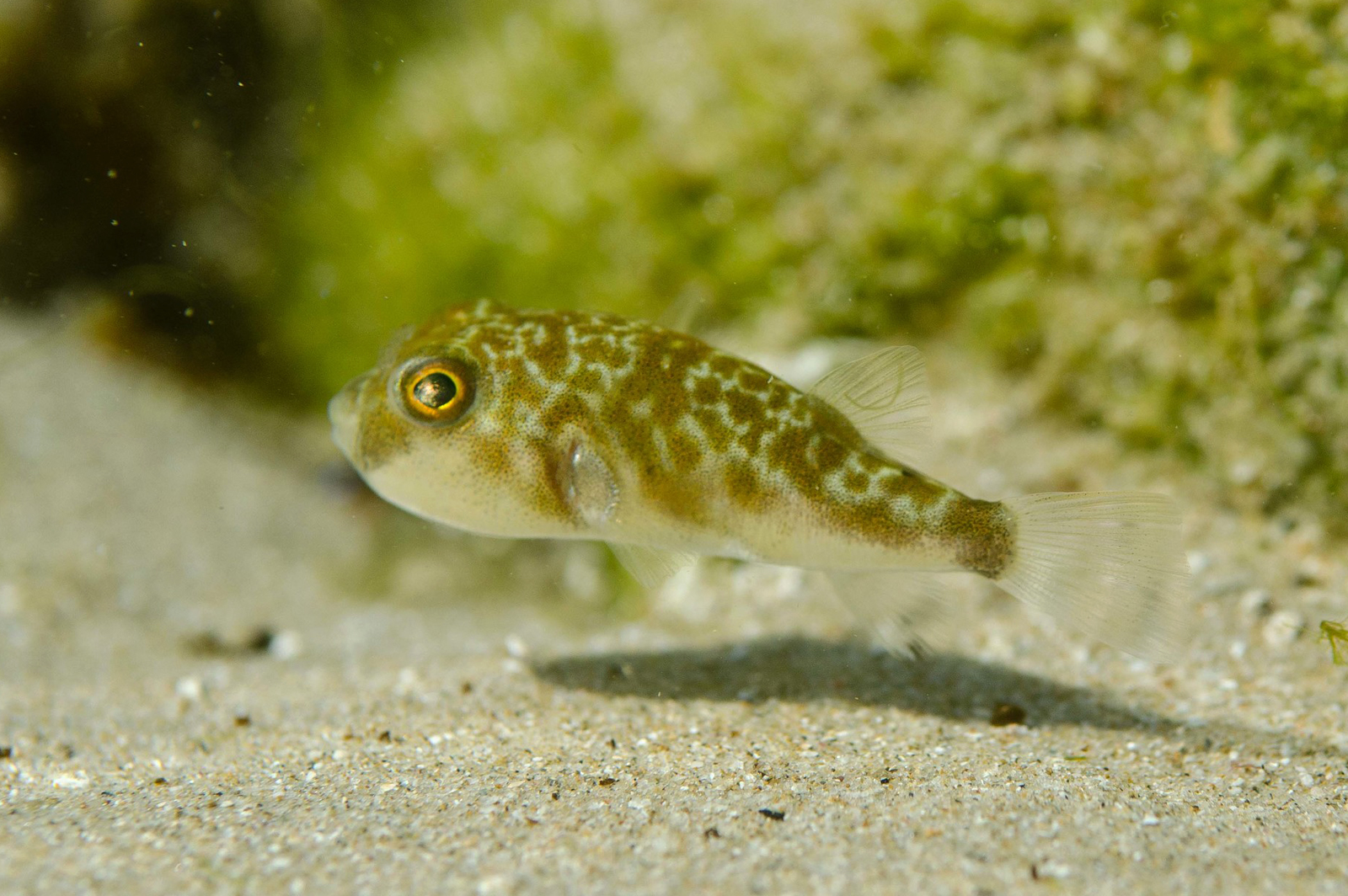Halstead's Toadfish, Reicheltia halsteadi (Whitley 1957)

A juvenile Halstead's Toadfish, Reicheltia halsteadi, at Sandy Beach, northern New South Wales, April 2014. Source: Ian Shaw / iNaturalist.org. License: CC by Attribution-NonCommercial
Summary:
A pale to olive-green pufferfish becoming white below, with a golden brown to brown mottled pattern on the back and the upper side, four to five indistinct darker bands across the back, a dark patch on the caudal peduncle, a reddish-brown patch before the lower part of the pectoral-fin base, and an orange iris.
Pufferfishes are poisonous and should not be consumed by humans or fed to pets.
Pufferfishes are poisonous and should not be consumed by humans or fed to pets.
Cite this page as:
Bray, D.J. 2021, Reicheltia halsteadi in Fishes of Australia, accessed 01 Jul 2025, https://fishesofaustralia.net.au/Home/species/876
Halstead's Toadfish, Reicheltia halsteadi (Whitley 1957)
More Info
|
Distribution |
South off Mackay, Queensland, to Nadgee, southern New South Wales; also the Lord Howe Province in the Tasman Sea. Usually inhabits sandy areas adjacent to reefs, and just beyond the surf zone. |
|
Features |
Dorsal fin 9-11; Anal fin 7-8; Pectoral fin 15-18; Caudal fin 11; vertebrae 7-9 + 10-11. Body elongate, rounded dorsally and somewhat flattened ventrally, tapering to a narrow caudal peduncle. Head length 2.7-3.3 in SL; body depth at posterior of dorsal fin 5.2-6.6 in SL; caudal peduncle length 4.2-4.8 in SL; least depth of caudal peduncle 9.9-11.9 in SL. Mouth small, terminal; lips moderately thick, covered with numerous short papillae. Chin lacking. Nasal organ a short, flattened papilla, anterior to eye, with 2 widely separated openings, posterior opening slightly larger; inner surface of papilla with several well developed flaps around circumference. Eye round, moderate in size, rim completely adnate, with the upper border level with or slightly interrupting dorsal profile, and the lower border well above level of mouth corner; horizontal diameter 2.9-3.9 in HL. Anterior edge of gill opening smooth. Pectoral fin rounded; dorsal fin located about level with anus, not reaching caudal-fin base, distal margin rounded. Anal fin base below posterior half of dorsal fin base, distal margin rounded, not reaching caudal-fin base; caudal fin rounded ventrally, otherwise truncate. Ventrolateral skin fold extending from behind pectoral fin margin to caudal fin; lateral line with small associated papilla, the line distinct on head and back, indistinct on caudal peduncle, encircling eye with an anterodorsal branch almost meeting mid-dorsally anterior to nasal organ and a pre-opercular branch extending almost to pectoral fin base; dorso-lateral branches of lateral line above pectoral-fin base may meet in midline; second lateral line dropping from behind mouth corner, extending along lateral region of belly to pectoral fin base; body spines short, 2- rooted, densely scattered on dorsum from between eyes to midway between pectoral-fin base and anterior end of dorsal-fin base, and on belly from beneath eyes to about 2/3 distance between pectoral fin base and anus; lateral surface free of spines. |
|
Colour |
Pale yellowish-green with many irregular light brown or reddish-brown blotches; darker brown bands cross back at eyes, between eyes and pectoral-fin base, just behind pectora- fin base and extending down side at dorsal fin base, and at caudal-fin base; brownish blotches and yellowish-green background continue to mid-lateral region, thereafter replaced by small, silverish-grey flecks gradually merging into white belly, silverish-grey sheen obvious on cheek and lower lateral surfaces; silverish-grey flecks form dense band under mouth, and are scattered thinly anterior to vent on spineless region of belly, at posterior of anal fin base and on undersurface of caudal peduncle (intensity and number of flecks vary according to individual); spinose region of belly white; all fins pale, a reddish- brown patch on anterior of pectoral fin insert. |
|
Fisheries |
The species is occasionally taken in trawls. |
|
Etymology |
The species is named in honour of Dr. Bruce W. Halstead of California for his studies on poisonous and venomous fishes. |
|
Species Citation |
Sphaeroides halsteadi Whitley 1957, Proceedings of the Royal Zoological Society of New South Wales 1955–56: 70, fig. 12. Type locality: Chinamans Beach, Sydney Harbour, New South Wales. |
|
Author |
Bray, D.J. 2021 |
|
Resources |
Halstead's Toadfish, Reicheltia halsteadi (Whitley 1957)
References
Hardy, G.S. 1982. Two new generic names for some Australian pufferfishes (Tetraodontiformes : Tetraodontidae), with species redescriptions and osteological comparisons. The Australian Zoologist 21(1): 1-24 figs 1-6 https://doi.org/10.7882/AZ.1982.001 See ref at BHL
Hutchins, J.B. & Swainston, R. 1986. Sea Fishes of Southern Australia. Complete field guide for anglers and divers. Perth : Swainston Publishing 180 pp.
Johnson, J.W. 2010. Fishes of the Moreton Bay Marine Park and adjacent continental shelf waters, Queensland, Australia. pp. 299-353 in Davie, P.J.F. & Phillips, J.A. Proceedings of the Thirteenth International Marine Biological Workshop, The Marine Fauna and Flora of Moreton Bay. Memoirs of the Queensland Museum 54(3)
Kuiter, R.H. 1993. Coastal Fishes of South-eastern Australia. Bathurst : Crawford House Press 437 pp.
Kuiter, R.H. 1996. Guide to Sea Fishes of Australia. A comprehensive reference for divers and fishermen. Sydney, NSW, Australia : New Holland Publishers xvii, 434 pp.
Shao, K., Liu, M., Hardy, G., Jing, L., Leis, J.L. & Matsuura, K. 2014. Reicheltia halsteadi. The IUCN Red List of Threatened Species 2014: e.T193685A2260243. http://dx.doi.org/10.2305/IUCN.UK.2014-3.RLTS.T193685A2260243.en. Downloaded on 02 October 2019.
Waite, E.R. 1900. Additions to the fish-fauna of Lord Howe Island. Records of the Australian Museum 3(7): 193-209 figs 1-2 pls 34-36 (misidentified in part as Amblyrhynchotus oblongus) https://doi.org/10.3853/j.0067-1975.3.1900.1171
Waite, E.R. 1904. A synopsis of the fishes of New South Wales. Memoirs of the New South Wales Naturalists' Club 2: 1-59 (misidentified as Sphaeroides oblongus)
Waite, E.R. 1904. Catalogue of the fishes of Lord Howe Island. Records of the Australian Museum 5(3): 187–230 (misidentified as Sphaeroides oblongus) https://doi.org/10.3853/j.0067-1975.5.1904.1053
Whitley, G.P. 1957. Ichthyological Illustrations. Proceedings of the Royal Zoological Society of New South Wales 1955–56: 56-71, figs 1-12 See ref at BHL








